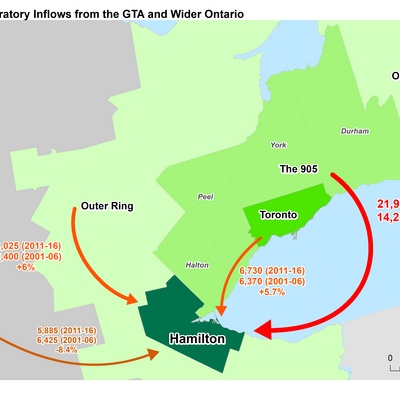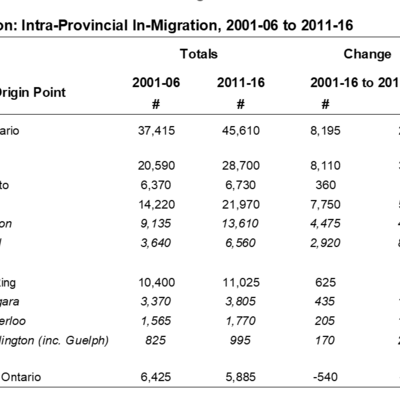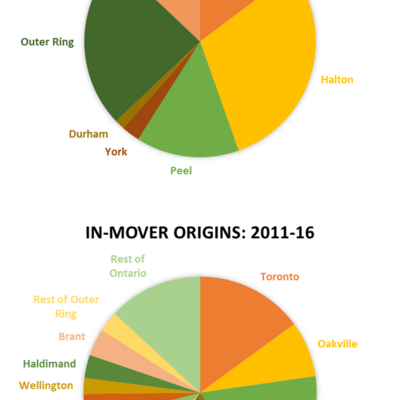New Report: Moving to Hamilton: the numbers behind the anecdotes, by Brian Doucet and Brayden Wilson is now public. You can download the full report here
Moving to Hamilton
It sometimes seems as if everyone knows someone, who knows someone who has moved to Hamilton! But to date, no one has counted how many people have moved, which cities they have moved from and into which Hamilton neighbourhoods they are moving to. Moving to Hamilton is therefore both one of the most hotly discussed, and empirically empty planning topics in southern Ontario.
Hamilton’s proximity to the Greater Toronto Area (GTA), combined with comparatively cheaper housing costs, walkable neighbourhoods, a vibrant arts scene, and its access to nature makes it an attractive alternative to overpriced, congested Toronto. Media stories abound with anecdotes of Torontonians who have moved down the QEW to set up a new life in Hamilton. Typically, these anecdotes revolve around a Toronto couple living in a small house or condominium downtown, in neighbourhoods such as Liberty Village or CityPlace.
One thing is clear: moving from Toronto to Hamilton is a major topic of conversation in both cities. The problem is that the planning, policy, political and public conversations around this migration are based primarily around anecdotes, rather than concrete numbers. To date, no one has calculated how many people have moved from the City of Toronto (and the rest of the GTA) into Hamilton, and where within the City of Hamilton these new residents are settling. This information is urgently needed as intra-provincial migration (that is, people moving from elsewhere in Ontario) is the main source of new inhabitants who move to Hamilton.
Using data from the 2016 and 2006 Canadian Census, the aim of this atlas is to provide empirically-grounded and detailed data on migration patterns from the Toronto Region to the City of Hamilton. This is done in order to move beyond anecdotes and provide the necessary information to make informed planning, policy and political decisions.
Four inter-related questions guide this report:
- How many people have moved to Hamilton from different parts of the GTA, and the rest of Ontario?
- To what extent did these migration flows change between 2006 and 2016?
- What Hamilton neighbourhoods are in-migrants settling in?
- To what extent do these Hamilton neighbourhoods vary based on the city or region that people are moving from?
Big trends
- The largest source of in-migration from ‘Toronto’ to Hamilton does not come from the City of Toronto, but rather the rest of the Greater Toronto Area which surrounds it. Often referred to as ‘the 905’ it consists of Halton, Peel, York, and Durham Regions. Within the 905 Region, Halton and Peel Regions are the biggest sources of in-migrants to Hamilton.
- Within Hamilton, in-migration from the 905 Region is predominantly suburban in nature. That is, households moving from the suburbs around Toronto are largely settling in amalgamated parts of the City of Hamilton, such as Ancaster, Flamborough, Glanbrook, and Dundas.
- In-migration from the 905 Region has also seen the largest growth rates. Between 2001-06 and 2011-16, this source of new residents grew by 54.5%.
- Migration from the City of Toronto remained relatively stable between 2001-06 and 2011-16 at 6,370 and 6,730, respectively.
- A greater percentage of in-migrants from the City of Toronto settle within the Lower City of Hamilton than those originating from the 905 or the Outer Ring of the Greater Golden Horseshoe (GGH).
- Despite having a population one-fifth the size of the City of Toronto, more people moved to Hamilton from Halton Region (Burlington, Oakville, Milton) than from the City of Toronto.
- More people move to Hamilton from the Outer Ring of the Greater Golden Horseshoe than from the
- City of Toronto. (The Outer Ring of the GGH includes Waterloo Region, Guelph, Barrie, Peterborough, Brantford, St Catharines, and Niagara).
- Within the City of Hamilton, the Mountain is the area that receives the fewest in-migrants from elsewhere in Ontario.

Migratory Data
We will update this report when data becomes available from the 2021 Census. If you would like to read the full report, you can access it here






